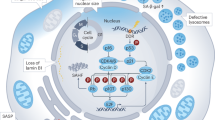Abstract
Bombesins are potent growth factors for murine Swiss 3T3 cells. Using these cells in chemically defined conditions we have been able to characterise the bombesin receptor and the early signals preceding DNA synthesis. We describe two substance P analogues [DArg1, DPro2, DTrp7,9, Leu11] substance P and [DArg1, DPhe5, DTrp7,9, Leu11] substance P which competitively block the binding of bombesins to their receptor and all the events leading to mitogenesis. Bombesins are secreted by human small cell lung cancers (SCLC) and may act as autocrine growth factors for these tumours, so the development of peptide bombesin antagonists could have therapeutic implications. We demonstrate that the antagonists can reversibly inhibit the growth of SCLC in vitro, with relatively little effect on other lung tumours.
This is a preview of subscription content, access via your institution
Access options
Subscribe to this journal
Receive 24 print issues and online access
$259.00 per year
only $10.79 per issue
Buy this article
- Purchase on Springer Link
- Instant access to full article PDF
Prices may be subject to local taxes which are calculated during checkout
Similar content being viewed by others
Author information
Authors and Affiliations
Additional information
Presented, by invitation at the BACR/CRC/ICRF Symposium on 'Growth factors', London, December 1987.
Rights and permissions
About this article
Cite this article
Woll, P., Rozengurt, E. Bombesin and bombesin antagonists: Studies in Swiss 3T3 cells and human small cell lung cancer. Br J Cancer 57, 579–586 (1988). https://doi.org/10.1038/bjc.1988.132
Issue Date:
DOI: https://doi.org/10.1038/bjc.1988.132
This article is cited by
-
New cytotoxic drugs and targets in oncology
Pharmaceutisch Weekblad Scientific Edition (1992)



